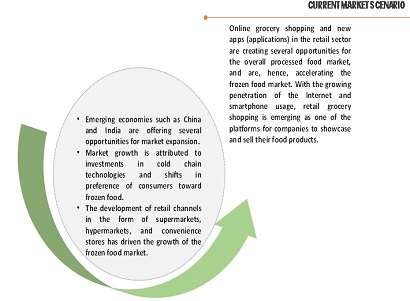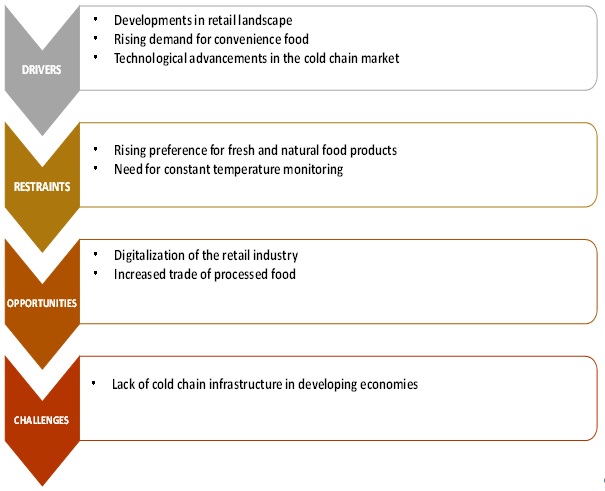|
|
|
You can get e-magazine links on WhatsApp. Click here
|
|
|
|
|
|
Movement in online grocery shopping accelerating frozen food segment
|
|
Friday, 12 April, 2019, 08 : 00 AM [IST]
|
|
Aslam Shaikh and Nagesh Manepalli
|
Frozen foods are food products preserved and kept frozen until used for cooking or direct consumption. The frozen food market is estimated to be valued at US$219.87 billion in 2018 and is projected to grow at a CAGR (compounded annual growth rate) of 5.14% during the forecast period; it is projected to reach US$282.50 billion by 2023. Frozen food products are increasingly becoming an integral part of the daily diet of people around the world, especially in European countries. Busy lifestyles have driven the food manufacturing industry to produce new products that could meet the rising demand from consumers, which, in turn, fuels the overall frozen food market.
Online grocery shopping and new apps (applications) in the retail sector are creating several opportunities for the overall processed food market, and are, hence, accelerating the frozen food market. With the growing penetration of the Internet and smartphone usage, retail grocery shopping is emerging as one of the platforms for companies to showcase and sell their food products. The convenience food & ready meals segment is projected to dominate the frozen food market by 2023.
The food service segment accounted for a larger share of the global frozen food market. This segment includes the large food chains that contribute to the growth for frozen products. Changes in lifestyles and high disposable incomes have led the working class to rely on ready-to-eat meals, which help them save time and effort.
The raw material segment is estimated to acquire the largest share of the frozen food market. The reason for this is that the products covered in this segment can be preserved for a longer period of time at home and restaurants and can be used as per consumers’ convenience.
FROZEN FOOD – CURRENT MARKET SCENARIO

1.1FROZEN FOOD: PRODUCT Fruits & vegetables
Emerging markets such as Russia, India, and Latin American countries have huge potential for frozen fruits & vegetables due to lower adoption rates. Growth in the frozen food market is stagnating in countries such as the UK, Germany, and the Scandinavia due to the maturity of the markets.
Additionally, countries such as Italy and Spain provide ample opportunities for market penetration of these products.
Dairy products The frozen dairy products include ice cream and frozen yogurts. Ice cream is currently dominating the frozen dessert market due to its high market penetration and increasing consumption. The ice cream market has a wide product offering with different flavours. The rising health-cautiousness among consumers has also enabled ice cream manufacturers to introduce low-calorie ice creams and frozen yogurts. The changing preference of consumers to low-fat and sugar-free products has boosted the demand for frozen yogurts in the market.
Bakery products Freezing is used to preserve food for a longer period of time. Earlier, frozen fully baked products faced some limitations due to the problem of crust flaking, which was overcome by the usage of yeasted frozen dough. Since then, yeast has played an important role in the processing of bakery products. Frozen bakery products are gaining popularity because they have extended shelf-life and aid in the production of freshly baked products while saving equipment and labour costs.
Meat & seafood products The frozen meat market is highly concentrated in the US and Europe, where the per capita consumption of meat is higher compared to the Asian countries. The frozen food market is concentrated in the US and Europe. In the overall frozen food market, frozen meat & seafood comprises about 24%. Freezing the fish quickly, i.e., at 40 degree Celsius, makes it more nutritious than the regular fish, as the latter loses out on nutrients during transportation. The most popular frozen sea-food includes Alaska Pollock, salmon, trout, rosefish, prawns, plaice, shrimps, cod, octopus, and others.
Convenience foods & ready meals Convenience foods & ready meals consist of frozen ramen, frozen soup, meat dishes, seafood dishes, fried rice, and many more. Any food item that is half-cooked and further needs to be cooked for a little while before serving is included in frozen convenience foods. Consumers have become very thoughtful about the prices of the products they consume, and this trend is followed in the food segment as well. The frozen food provides a cheaper option and thus is favoured by consumers.
1.2 MARKET DYNAMICS

Source: Company Press Releases, Investor Presentations, Food Journals, Expert Interviews, and MarketsandMarkets Analysis
1.3 CONSUMPTION
Frozen foods do not need any preservatives, as freezing itself is a natural form of preservation. There are varieties of frozen foods available in the market. These include ready-to-eat meals, bakery products, dairy and dessert items, and many more. Nowadays, frozen foods are not only bought by consumers from retail outlets but are also by the food service industry, as they are not only easy to prepare but are nutritious and tasty. Younger urban millennials prefer to have quick delivery restaurant foods; thus, frozen food manufacturers are using this as an opportunity to expand their businesses in the market.
1.3.1 FOOD SERVICE
The food service industry includes restaurants, QSRs (quick service restaurants), pubs, hotels, and healthcare, among others. Among these, QSRs dominate the food service segment in the frozen food market due to the high contribution of QSR chains—such as McDonald’s, Starbucks, Subway, Burger King, Pizza Hut, KFC, and Dominoes—with their large number of outlets across the world. The food service industry uses frozen food items on a regular basis to save time in cooking; this reduces the time taken by the food item to reach customers’ table.
1.3.2 RETAIL
The retail segment has shown significant growth, particularly in the food and grocery category. The supermarket sector for the distribution of frozen products is growing due to the increasing investment by various retail players. Convenience stores are usually small family-owned businesses at a single location. They do not have multiple operations such as franchises and large corporations. The increase in demand for convenience foods, along with the higher spending capacity of people, have enabled these stores to upgrade their infrastructure, which includes freezing and temperature-controlled facilities, thereby enabling growth for frozen products.
1.4 FROZEN FOOD: FUTURE PERSPECTIVE
Globalisation and increasing international trade are the main factors for the development of the frozen food industry, globally. With economic development and increasing purchasing power parity (PPP), consumers can afford premium products with improved nutritional value and shelf life. This drives the trade of various food products between regions. According to the Agriculture Marketing Resource Centre (AGMRC), the US is the world’s largest producer of strawberries. In 2014, it produced 3 billion pounds of strawberries, valued at US$2.9 billion, of which, 63.4 million pounds of frozen strawberries were exported, valued at US$45 million.
The global seafood market is also witnessing immense growth due to the health benefits offered by these products. According to the Food and Agriculture Organization of United Nations (FAO), an estimated 2.3% hike in global fish production combined with good market conditions around the world led to a significant boost to trade revenues in 2017. India, Peru, Ecuador, Chile, and Norway were the top exporters of seafood in 2017. Increasing export and import of such products boosts the overall frozen food market growth.
(Shaikh is team lead (research), food, beverage, animal feed & agriculture, and Manepalli is head, food, beverage, animal feed & agriculture, MarketsandMarkets Research Pvt. Ltd. They can be contacted at aslam.shaikh@marketsandmarkets.com)
|
|
|
|
|
|
|
|
|
|